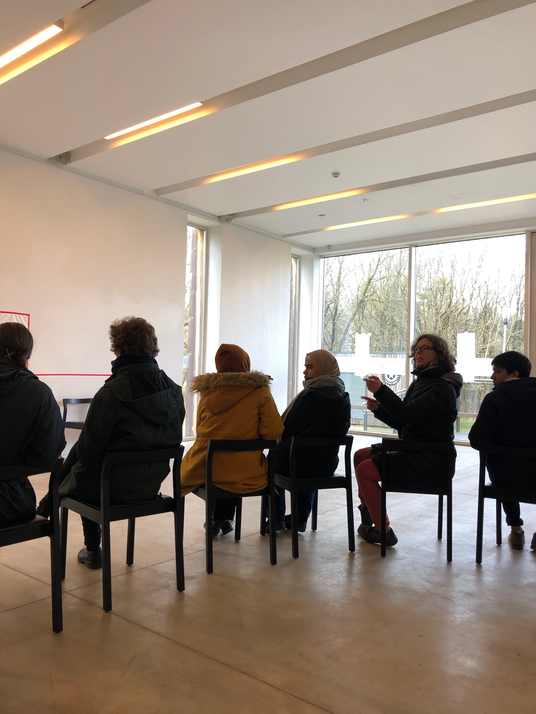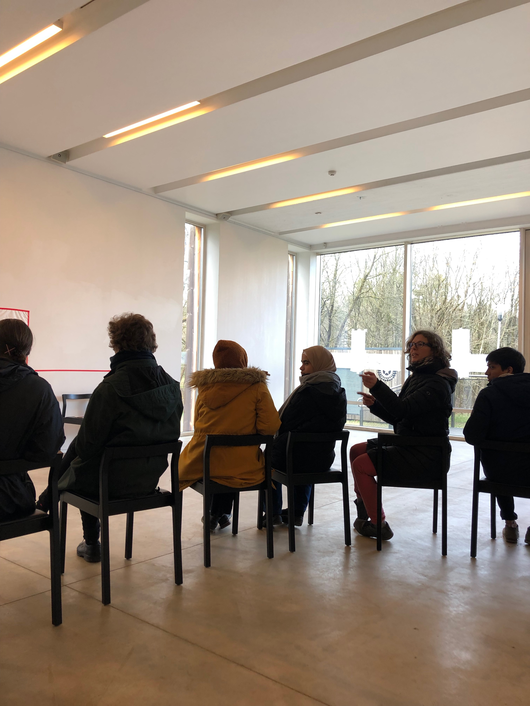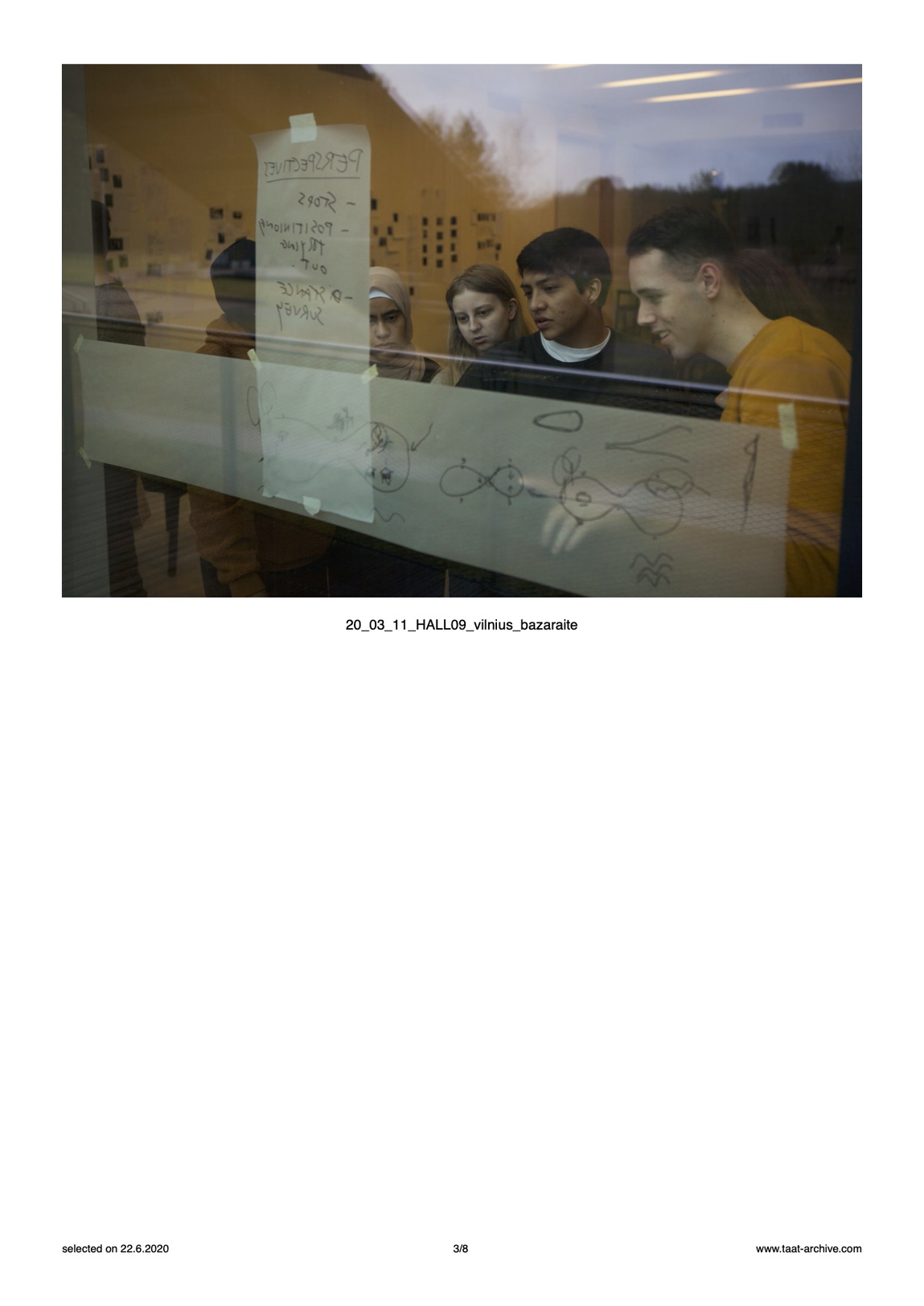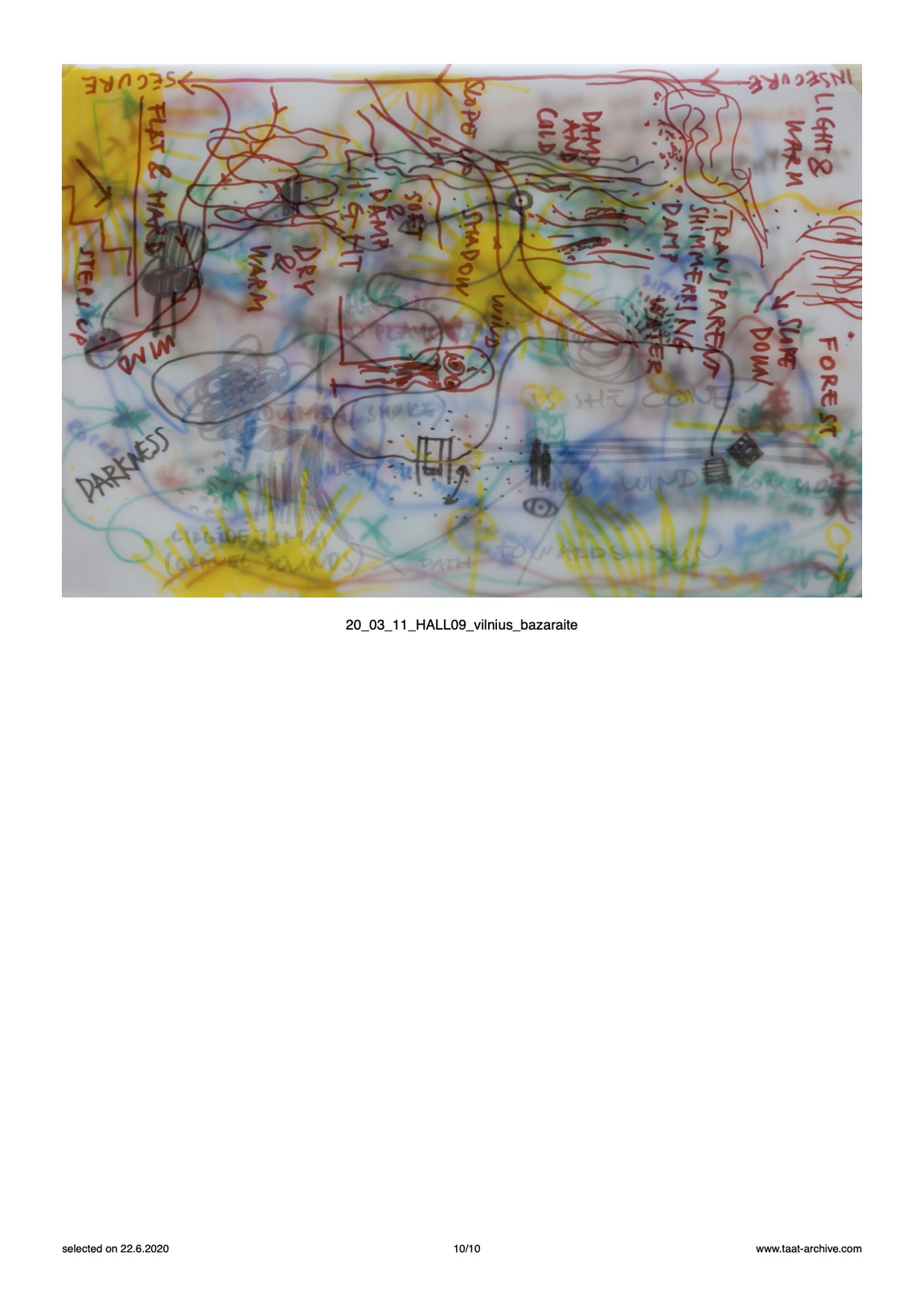ACTION
Performed/staged actions and gestures
Gert-Jan, Breg & Siebren take a Bolt Taxi at the Lidl supermarket to Pakranté. Last preparations for the workshop: sticking papers on the windows of the gallery to give the five subgroups a sheet of paper to visualize their dramaturgical ideas.
The first participants arrive at Pakranté. Most of the group arrive a bit later. Because of the Restoration of Independence Day, there are only a few buses (public transport) in the morning driving to Pakranté. Eglé decides to drive some of the participants from the city to Pakranté. (kan ook worden weggelaten)
Introduction/check-in: we create a (proactive) circle inside the gallery space, close to the paper sheets on the windows. Each one can express the way they feel to step into the second part of the workshop, this in their own language.
Siebren shares with the group that he plans to organize interviews during the whole day with different participants to talk about their experience during the workshop.
The dramaturgy of the interview:
First the interviewee visualizes the way he/she experienced the workshop on a sheet of paper. Then the conversation-like interview is organized around the visualization, in relation with the following questions: How did you experienced the workshop?; What was peculiar interesting or inspiring for you? (why?); What did you learned during the workshop?; What do you want to tell your grandmother about your experiences during the workshop?
Continuation of the subgroup exercise of the first day of the workshop: each subgroup formulate and visualize dramaturgical ideas to create the walking performance, according to their perspective (intro; paths & sings; perspectives; outro; overview).
The different subgroups present their ideas to the whole group of participants. The rest of the group can ask questions or respond to each other’s’ (dramaturgical) ideas. Some participants repeat their own dramaturgical idea several times, and, by doing this, ignore follow the rhythm or dynamic of the exchange in the group.
A trust game/exercise: the group is divided in pairs; in each pair one person lead and the other follows, where one of the two is blindfolded, and the other leads him/her.
Lunch break
Finalization of the dramaturgy for a new walking performance. Different ideas are exchanged. At a certain moment the co-creative process went to a deadlock, or didn’t move further. Gert-Jan & Breg decided to share a dramaturgical idea to work further on, and visualize this on a paper on the window. In a couple of minutes the group creates a whole new walking performance. Gert-Jan calls this ‘swarm thinking’, when collective intelligence creates something new and unexpted, as the outcome of their collaborative thinking and working together.
Curatorial intervention in the gallery space: in the middle of the space chairs are placed in a circle. At the left-hand wall (at the opposite of the Hall-timeline) there is one chair placed, with a red taped frame on the wall around it. We immediately start the new created walking performance by searching a place to sit on the chairs, and wait blindfolded till they come ask us to follow. The intro subgroup makes pairs to start the walking performance. One person guides the other one through a self-chosen trajectory. Another duo interacts with the first duo, by choosing stopping points to communicate non-verbally. When the duo's are back at the starting point of the trajectory, the pairs change their role. The outro group invites the participants to visualize their trajectory on a piece of paper, and write some words down to express their embodied experience.
Reflection circle: inside the gallery space we place chairs in a circle-shape to share with the group our own embodied experience based on the (co-created) walking experience.
Tune out with the whole group: we move the chairs to the side of the gallery space and decide to stand in a circle. We collectively tune out by sharing one word with each other to express the way each one will leave the workshop.
Eglé drives Gert-Jan, Breg & Siebren to the historical city centre, and gives us an architectural and historical tour through different parts of the city.
Dinner with Eglé, Gert-Jan, Breg & Siebren
LIVE ARCHIVE FOOTAGE
Footage printed directly from http://www.taat-projects.com.s3-website.eu-central-1.amazonaws.com/
REFLECTIVE NOTES
Questioning/thinking on meaningful and critical moments
The exchange of dramaturgical ideas by the different subgroups is for me an exercise in mobilizing questions. This is an interesting dramaturgical strategy to fuel ideas from the subgroups and create a co-creative forum (cf. Georgelou et al., 2018). The moment when one participant keeps repeating her own idea, was for me a critical moment: how do you respond to this as a ‘facilitator’ of a co-creative process? This can influence the group dynamic (in a negative way). (S.N.)
A Tower of Babel is created by this exercise. During the rest of the day, a lot of the participants talk in their own language to each other, instead of using English as the lingua franca in this international workshop. Compared to the first day everybody communicated in English. (S.N.)
The trust exercise is linked to one of the dramaturgical ideas in the new walking performance. The idea of control or leading versus being led, is also an important aspect in the dramaturgy of TAAT. (S.N.)
The group exchange works for me as a movement from exchanging ideas (by 'mobilizing questions') towards ‘commonality’ by searching a common ground (cf. 'commoning'). Important here is the in-between stage of ‘alienating’ (cf. Georgelou et al., 2018). The interruption by Breg and Gert-Jan was for me the ‘alienating’ moment. At a certain moment they propose a dramaturgical idea for the walking performance (Breg visualizes this on a sheet of paper). This was not an hierarchical way of verticalizing the co-creative process, but brought something new in (as an alienating strategy), because the co-creative process went ‘stuck’ or didn't move further. I call this an example of ‘leadingbyfollowing’ (cf. André Lepecki), because they followed the co-creative dynamic of the group. (S.N.)
The reflection method of visualizing the walking experience, is interesting as a tool for reflecting the embodied experience. The reflection is based on a mental map method (cf. Kevin Lynch), with the aim to draw the route of the walk on a paper, and to annotate the visualization with words who describe the experience. The difficulty lies still in the way an embodied experience can be visualized (a translation from a multisensory to a unisensory interpretation). In the reflection of the embodied experience the interrelation of the embodied time, space and actions/gestures is at the fore, as a way to try to grasp or interpret the ‘embodied space’. (S.N.)
EXTRACTION
What are the revealing threads, connections and relationships?
The ‘in-between zone’ is the playground in the work of TAAT. In-between disciplines, in-between spheres, in-between dramaturgies, between performer and spectator, between theory and practice or research and dramaturgy. (S.N.)
This implicates the work of TAAT enables the potentiality to explore and take-up a combination of these positions, by continually shifting and oscillating in-between these roles and positions. (cf. James Frieze, 2016) (S.N.)
As a final extraction, first a simple question: where are we extracting from, if everything is part of the same content?
Institutional assumptions
I have the feeling we came quite far (between HALL01 and now) in deconstructing HALL33 as a project-as-proces, starting from assumptions and dichotomies concearning disciplinary conditions, mechanisms of authorship and modes of collaboration.-> expand on the conversation with the project partners and Pakrante as an 'in between space'.
Within the social mission of facilitating encounters, there is an implicit mission to make the 'institutional' assumptions tangeble and relational. It is in between the social and the institutional we have found a constructive and effective attitude through the performativity of our work in order to raise societal impact. (As mentioned in von Hantelmann's final chapter of How to Do Things with Art).
The turn 'towards the environment' that we took from HALL07, led us into a fundamentally different view on our practice moving from deconstruction to reconstruction of the above mentioned assumptians. -> state how the turn towards the environment - through pakrante, the intitution and working there -
I feel we're on a point that we're not only acknowledging the 'in between' as a way to bridge dichotomies, in favour of finding a natural fluidity between things.
As much as we dramaturgically explore this fluidity between human and non-human elements, we are - on a discursive level - interrelating and extrapolating concepts, ideas and thoughts to an extent that their meanings merge. We're aknowledging the 'discourse in context' as an ecosystem, exploring our collective curiousity of what Kershaw calls the 'ecolacunae', being the elements of an ecosystem we do not yet know. I believe that the only way to practice this discourse in context is to build the discourse from a collective curiousity, in which the environment operates as a third term. (see extraction March 10th).
This collective relational discourse operates as a holistic methodology of knowledge production within the ecosystem of HALL09. It's important to aknowledge this 'in between' discourse as a new kind of speaking and writing, embracing the performativity of the discourse itself to catalyse relational and co-creational mechanisms in knowledge production.
Let us therefor not step into the trap to instrumentalize 'the in between' as a graspable thing, but to embrace the fluidity and relationality of this discursive proces as an 'iterative discours'. (B.H.)
Key moments in the workshop dramaturgy
11. Continuation of the subgroup exercise of the first day
Clearly everybody was committed to making the work. For the introduction/tune in we needed to nurish this enthusiasm and at the same time give some input/inspiration.
>>Why did we feel like giving that input/inspiration? People could have just continued working. We could have then found a moment to inspire/re-align the group if needed. Why couldn't we just follow them?
Isd this about (still) putting our mark on the process?)
12. The different subgroups present their ideas
It was interesting to not only hear the presentations but also immediately get an impression of the dynamics within each sub-group. Did they work together? Is one using the situation as a platform to present him/herself?
13. Finalization of the dramaturgy
The subgroups worked well on the level of focussing the design/creativity. But it didn't solve the decision-making. Maybe it couldn't? Or shouldn't? It felt appropriate that Gert-Jan & Breg channeled the idea into one proposition (flashback HALL06). This turned out to be the missing link and within minutes the piece was finished.
An example of how 'flexible hierarchy' as well as TAAT's hierarchical position is constructive?
14. 'Performance'
It was really great how the different groups took responsibility for their part. The whole thing went really smooth and was very rewarding for everybody. There was a lot of energy in the room during the individual feedback session.
15. Reflection circle:
To move that energy to a group reflection was a bit of a challenge, but it also acknowledged the ending of the workshopprocess. And also it connected the process with the context of the partners who were present and who listened and shared their perspective. This created an added value to the the group process
16. Doorstep moment
After the tune-out we ended up literally at the doorstep talking with a few participants. They were the people we would have picked to continue working with. And they stayed around to communicate they were interested in continuing working with us.
Iterative discours
With this Research catalogue we tried to shape an alternative space for discourse and its methodology, that solidifies in a iterative process of writing, reading, reacting, discussing, writing and reacting again. It never aimed to come to a 'grand' conclusion, but to include the 'act of concluding' as part of the HALL09 discourse, that in itself - as for the HALL33 project as a whole - might never come to a final conclusion.








